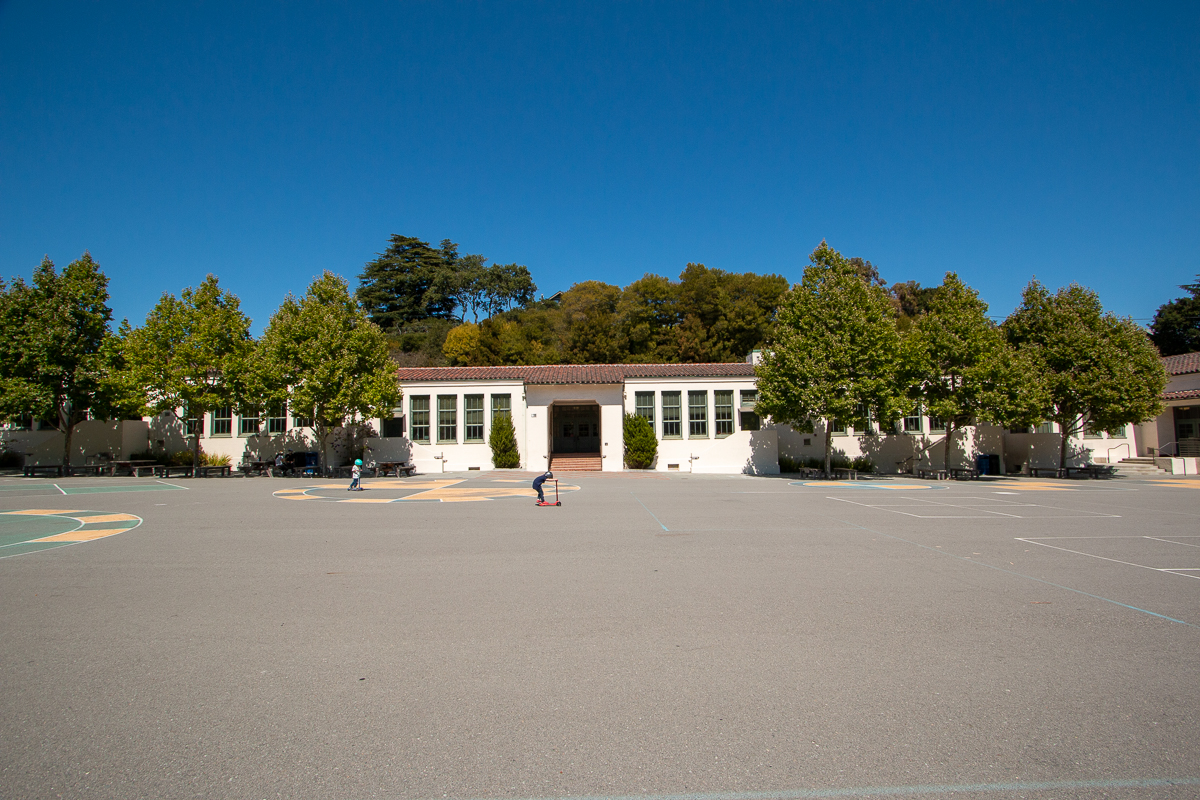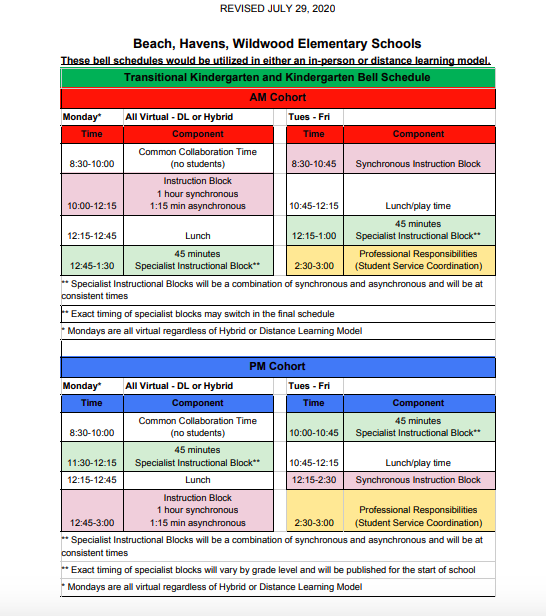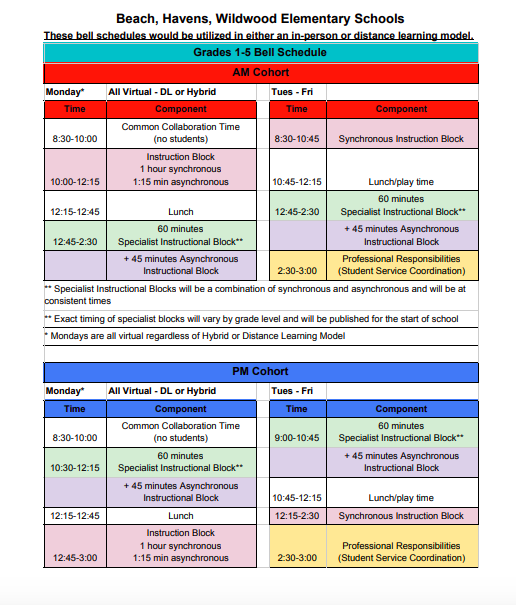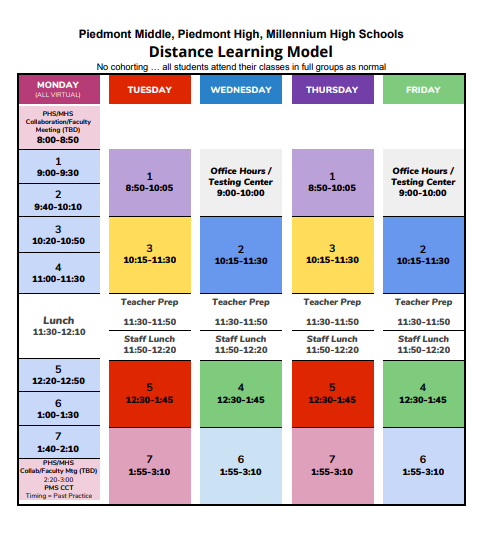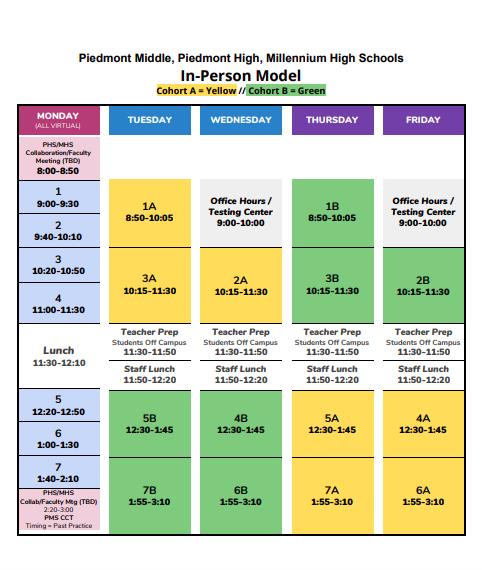At a July 29 special meeting, the Board of Education approved the 2020-21 daily instructional bell schedules for both the elementary and secondary levels. The parameters of the school day will apply to both distance and in-person learning. PUSD is starting the year in full distance learning mode for all grades until public health conditions improve.
PUSD administrators will present specifics of the district’s distance learning plan to the board during a special Board of Education meeting on August 5 at 5 p.m.
The schedules were a product of the collaboration of members of the Association of Piedmont Teachers (APT), members of the classified staff, and administrators who made up the Bell Schedule Committee.
“We had to create bell schedules that can be flexible enough to respond to the changes that we will continue to encounter as we start school,” said Superintendent Randall Booker.
Bell schedule parameters
The bell schedules follow certain parameters placed by the Board, Governor Newsom, the Alameda County Department of Education (ACDE), and the Alameda County Public Health Department (ACPHD).
The parameters are as follows:
- Students attend some form of school 4-5 days per week that incorporates both daily synchronous and asynchronous learning opportunities
- 180 minimum instructional minutes for kindergarten
- 230 minimum instructional minutes for 1st through 3rd grade
- 240 minimum instructional minutes for 4th through 12th grade
- Attendance is recorded daily
- Staff receive 30 minutes of duty-free lunch every day
- Direct instruction for both elementary and secondary levels does not exceed 20 hours per week
- Teachers at the elementary level receive a minimum of one-hour preparatory time per day
- Teachers at the secondary level receive a minimum of 475 minutes preparatory time per week
- The passing periods at the secondary level are limited to 10 minutes
Elementary schedules
At the elementary level, there are two separate schedules for TK and Kindergarten and the first through fifth grades. Both schedules cohort with an a.m. and p.m. group and would not change if the district shifted to a hybrid in-person model.
“Regardless of distance learning or an in-person hybrid model, we are going to move forward with cohorting of an a.m. and p.m. group,” Booker said.
The a.m. cohort would start with an instruction block containing a mixture of synchronous and asynchronous classes and then after lunch, transition to a 45-minute special instruction block.
“What we mean by a [specialist instruction] is going to the library, art, tech, and P.E. and such,” Booker said. “That could be a combination of both synchronous and asynchronous learning.”
The p.m. cohort would be the opposite.
“It’s basically flip-flopped,” Booker said. “So students start with their 45 minutes of Specialist Instructional Block and then after lunch they flow into their synchronous and asynchronous learning.”
There is a large cushion time in the middle of the day for lunch and — if some in-person teaching resumes — for cleaning between groups. “We need to be able to provide our staff with their 30-minute duty-free lunch and prep time, and on top of that, time for the custodians to clean classrooms between the a.m. and p.m. cohort,” Booker said.
Additionally, there is time built in to the schedule for teachers where they could communicate with parents.
Middle and high school schedules
At the secondary level, there are two separate schedules for the distance and hybrid in-person learning models. Mondays will be virtual in both models and students will be expected to show up at 8:50 or 9 a.m. every day for class.
“This is somewhat familiar to our middle and high school students in terms of a block schedule with a Monday full day which is what we saw in the past prior to COVID,” Booker said.
The schedule even includes office hours. “On Wednesday there are office hours and the testing center is open so students can make up tests and connect with their teachers if they need to,” Booker said.
In the event classes are able to resume with some in-person teaching later this year, students will be broken into two cohorts: A and B. Similar to the a.m./p.m. model in the elementary school, students would switch being on campus.
“Now that doesn’t mean that they aren’t doing anything during that time [off campus].,” Booker said. “This is when they’ll have opportunities for homework, possible asynchronous lessons, and everything else high school students would be doing throughout their day.”
To smoothly transition to a hybrid in-person model if the opportunity arises, classes for distance learning will be created with cohorting in mind, Booker said. However, he is unsure if students will be informed of which cohort they are a part of before the transition.
“We have to create a schedule that facilitates or groups the cohorts [now],” Booker said. “We can’t do it after the fact.”
As the school year begins, Booker said that he encourages families to bring structure and schedules into their homes. Students should act like they are physically attending school and be learning during the designated time even if it is asynchronous.
“Kids might complain about [structure] but at the same time I know that they crave it too and it is really important for their health,” he said.
Transitioning to hybrid learning
When Governor Newsom made the announcement mandating 32 counties on California’s watchlist to open with a distance learning model, he also provided guidelines for how to return to a hybrid in-person model of instruction.
The state criteria to pivot to a hybrid model of instruction is as follows:
- Alameda County is off the state’s monitoring list for at least 14 days
- Masks requirements followed by all students and staff
- Physical distancing requirements followed by all students and staff
- Regular testing and dedicated contact tracing
- Rigorous distance learning
Even if the numbers drop and the criteria is met for transitioning, the district will need time to transition and the transition most likely will not be permanent, Amal Smith said.
“Given the way people talk about the fall and the winter, it will be very likely we will have to pivot back to distance learning,” Smith said.
However, Pillsbury said that the Board, like the rest of the community, would love to be able to safely open to in-person learning.
“We’re all committed to opening as fully as safely possible,” Pillsbury said. “I don’t think distance learning is anyone’s first choice.”
Waivers for in-person teaching for K-3rd not in the cards right now
Governor Newsom also mentioned the opportunity for a TK-3rd Grade Waiver which would allow a local health officer to permit school districts to open in-person instruction for grades K-3 if requested by the superintendent in collaboration with labor, parent, and community organizations. However, neither the ACDE nor the ACDPH are accepting or signing waivers at this time due to the surge of COVID cases in the county.
“Even if we wanted to, we are not permitted [to acquire the waiver] at this time,” Booker said.
Booker said that an additional barrier in receiving this waiver is that the governor has not clarified how one would apply, nor has he spelled out what a waiver would mean as it relates to labor negotiations (i.e., with teachers’ unions).
Learning pods may be necessary for some, but can be problematic
Although the Board made it clear the district can not be involved with the organization of learning pods, they recognized that a lot of families are interested in forming them. Therefore, they will be pushing out the elementary a.m./p.m. cohort lists to families on Monday.
“We recognize that families are in need of finding childcare and supporting their students with distance learning,” Booker said.
However, Booker said that the Board hopes families will continue the district’s goals with their pods.
“The district can not be involved with the development of learning pods,” Booker said. “It is not our role or our responsibility. But we do ask families that are considering it to really think about our district’s focus of inclusivity, diversity, and acceptance.”
Booker said that learning pods, if executed in an exclusive manner, can perpetuate and sometimes even further inequities and learning gaps.
“I just can’t imagine what it would feel like to be that family that is trying but is left out or denied,” he said.
Smegal said that this is one of the reasons why ideally pods would be uniform across all schools.
“I think the idea is that maybe parent clubs can come in and find some way to help be a resource so that there is similarity across the elementary schools and if necessary the secondary schools,” Trustee Amal Smith said.
Screen time concern for elementary students
During the meeting, multiple parents of young students commented about the length of the elementary school synchronous class time. They feared that their students would not be able to concentrate on a screen for that long.
“We will have quite a bit of movement breaks and other strategies that we will use to get kids up and away from the screen and then come back,” Booker said. “Teachers are incredible that way — they are going to move kids around.”
Additionally, Booker said that more learning materials like workbooks and whiteboards are going to be sent home.
“[They are not going to be] inputting data into a screen but actually using pen and paper,” he said.
The school board meets to review the specifics of the distance learning plan during a special Board of Education meeting on August 5 at 5 p.m.
